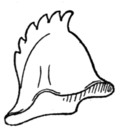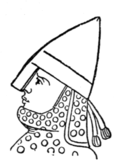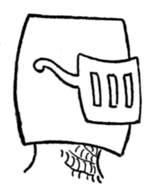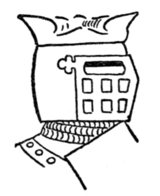and equally impossible size. Victorian heraldic artists, ignorant alike of the actual and the ceremonial, reduced the size even further, and until the recent revulsion in heraldic art, with its reversion to older types, and its copying of older examples, the helmets of heraldry had reached the uttermost limits of absurdity.
 Fig. 560. |
 Fig. 561. |
 Fig. 562. |
 Fig. 563. |
The recent revival of heraldry is due to men with accurate and extensive knowledge, and many recent examples of heraldic art well compare with ancient types. One happy result of this revival is a return to older and better types of the helmet. But it is little use discarding the "heraldic" helmet of the stationer's shop unless a better and more accurate result can be shown, so that it will be well to trace in detail the progress of the real helmet from earliest times.
In the Anglo-Saxon period the common helmet was merely a cap of leather, often four-cornered, and with a serrated comb (Figs. 560 and 561), but men of rank had a conical one of metal (Fig. 562), which was frequently richly gilt. About the time of Edward the Confessor a small piece, of varying breadth, called a "nasal," was added (Fig. 563), which, with a quilted or gamboised hood, or one of mail, well protected the face, leaving little more than the eyes exposed; and in this form the helmet continued in general use until towards the end of the twelfth century, when we find it merged into or supplanted by the "chapelle-
 Fig. 564. |
 Fig. 565. |
 Fig. 566. |
